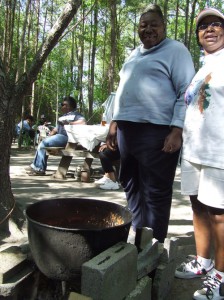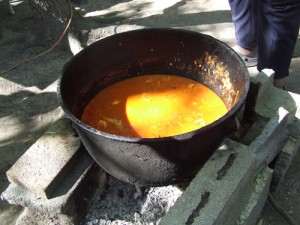by David Cecelski
“Wash tub” fish stews are a spring-time tradition along theNeuse River. When the shad and rockfish swim upriver to spawn, local fishermen take to the water and cooks get out their biggest pots. In the old days, that stew pot was often literally a tin wash tub. These days it’s more likely a big cast iron kettle or an aluminum pot, but the river’s people still call them “wash tub fish stews.” You’ll find them at church dinners, family reunions, and other community events, mostly in Lenoir, Pitt, Greene, and Wayne counties.
I stumbled onto a fish stew today in Fort Barnwell, a tiny community on NC 55. A hand-scrawled “fish stew” sign was on a mailbox in front of a trailer home. The ruins of the Newbold School, a historic African-American school, were just across the road.
I walked around back and discovered what turned out to be a fundraiser for a family reunion that they’re planning for this summer. There was a crowd, too: men relaxing in lawn chairs and lounging on old stumps, women sitting at picnic tables in the shade, and lots of children playing games, including a fierce game of checkers. And everybody was eating fish stew.
Next to a stack of hardwood, a pair of ladies was tending a fire under a black cast-iron stew pot. One of them, Ms. Sudie, walked over and greeted me warmly and led me over to the stew. When she took the lid off the kettle, I thought it was the prettiest stew I’d ever seen.
It’s a very traditional recipe in those parts: they take whole rockfish (or shad—but this was rockfish), bones and all, and cook it in a tomato broth with plenty of onions, potatoes, and a little fatback. They season it with black pepper and crushed red pepper, and they finish off the dish by cracking open whole eggs and dropping them into the hot broth.
Most of the fish bones settle to the bottom of the pot, but you always end up with a few bones in your bowl. The idea is that you just go slow and eat around them.
The eggs are an essential fish stew ingredient along theNeuse River. I usually see the stew with sliced hard-boiled eggs, but Sudie and her mom use raw eggs so they’ll flavor the broth better.
I was the only stranger there, but Sudie and all her friends and family were very welcoming. The ladies ladled me out a big bowl of stew and I sat at a picnic table under the trees and enjoyed the lovely spring day, a game of checkers, and the aroma of the smoke and the stew.
This weekend you can get this kind of fish stew at the Grifton Shad Festival, which celebrates its 40th year on April 17 and 18. Grifton is on Contentnea Creek, one of the Neuse’s tributaries, and the festival is a delight. This year’s festival theme: “Peace, Love, and Shad.” It includes lots of good food, but also parades, rides, kids’ games, and a fishing tournament. You can find details, as well as a recipe for the local Lion Club’s fish stew, at the shad festival’s web site,www.grifton.com/shadfest.html.


Leave a Reply